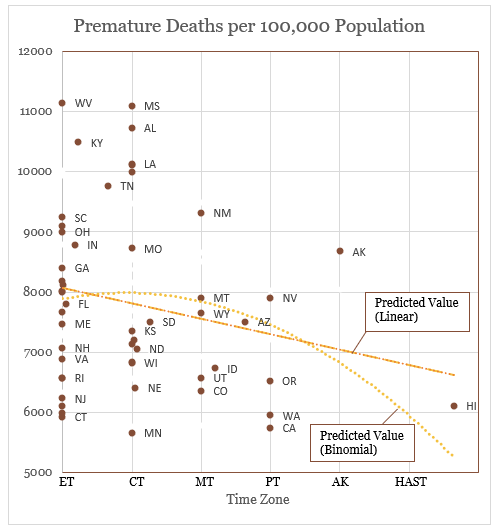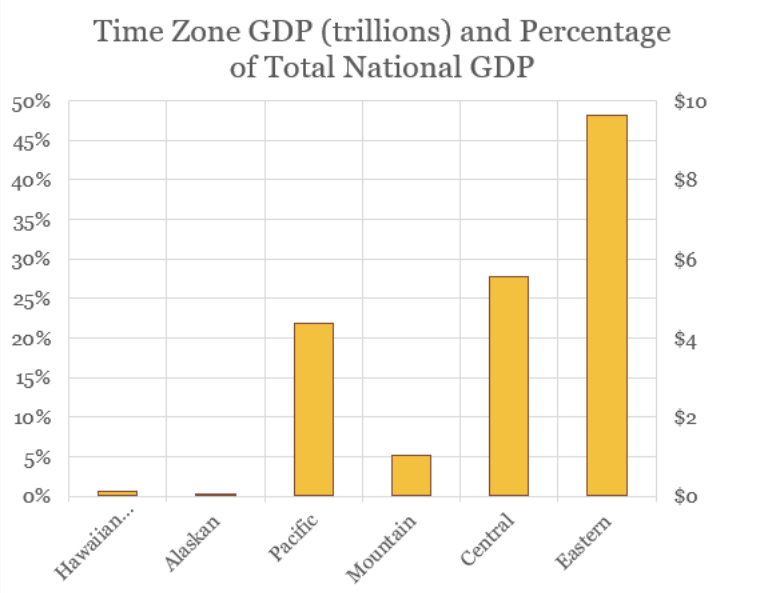
Coastal Centrality, Conservatism, and Premature Death Rates
This is part two of a series of pieces on premature deaths in America and the role our distance from the centers of power in this country have on that. Click here to read part one.
Last week, we examined premature deaths in America and a potential correlation with what we called “East Coast centrality.” This notion — that the East Coast’s dominance over media, sports, government, and especially on working hours is detrimental to health and life outcomes in the western parts of the United States — was tested on 2018 data, controlling for unemployment in each state (and the District of Columbia) and deaths per 100 vehicle miles traveled. This uncovered that the effective time zone (representative of the number of hours away a state is, on average, from Eastern Time) is a significant variable in premature deaths,but that this relationship was actually negative. Contrary to the original hypothesis and controlling for unemployment and vehicle miles traveled, premature deaths decreased as we moved further west.

So what were we missing? The data pointed to the effective time zone remaining a statistically significant variable, but it wasn’t until we looked at our final regression model that a couple of other potential variables became apparent. What if East Coast centrality was important, but not by itself — what if coastal centrality in general was driving premature death rates?
When we look at a binomial line of best fit for regression, as opposed to the linear predicted value, this becomes obvious; there are fewer expected premature deaths in Eastern Time, before rising slightly in Central Time and then tapering off dramatically in the Pacific, Alaskan, and Hawaiian-Aleutian time zones. It’s time to reframe how we think of coastal centrality.
Effective Time Zone Hegemony
This is going to get a little complicated. Eastern Time is so pervasive in American culture because of its weight on media, business, government, and the economy, or at least so goes our premise. It’s also the time zone in which the plurality of the United States’ population resides. The best way to weight the combination of these factors is my good friend, gross domestic product (or GDP). Using the Bureau of Economic Analysis’ 2018 GDP by state data, we will apply each state’s GDP to the proportion of the time zone(s) in which its population resides. So, while Maine’s GDP of $64.6 billion is applied 100% to Eastern Time, Idaho — 80% of whose population resides in Mountain Time and 20% in Pacific Time — will have its $79.1 billion GDP applied 80% to Mountain Time and 20% to Pacific Time.
Reframed by time zone, we can establish gross time zone product within the United States:
| Time Zone | Time Zone GDP (millions of dollars) | Percent of Total |
| Eastern | $9,644,668.35 | 46.63% |
| Central | $5,528,564.98 | 26.73% |
| Mountain | $1,005,433.02 | 4.86% |
| Pacific | $4,358,188.75 | 21.07% |
| Alaskan | $53,858.56 | 0.26% |
| Hawaiian-Aleutian | $93,534.84 | 0.45% |

As if it weren’t already apparent, the Eastern Time Zone absolutely dominates. Nearly 47% of all economic activity in the United States occurs in the Eastern Time Zone. And Mountain Time pales in comparison to its neighboring Pacific and Central time zones, as the Hawaiian-Aluetian and Alaskan time zones are fractions of a percentage compared to Pacific Time. This lends credence to the bimodal coastal hegemonies theory we’ll be applying to the original research.
We will use this percentage of total time zone GDP as our measure for the hegemony of each time zone, applying it to each state based on its effective time zone. So, to use Idaho as an example again, 80% of Idaho will be weighted 4.86 for Mountain Time and 20% will be weighted 21.07 for Pacific Time, giving Idaho a value of 8.1 for its effective time zone hegemony. Time to run a regression…
We still have a moderate correlation, with around 57% of the variance in premature deaths explained by this new model according to the adjusted R square. Effective time zone hegemony is significant well below the 0.05 required, as are our control variables from the previous model. One thing has changed dramatically though, and that is our coefficient for our most explicit time zone-related variable. It is now positive at 30.25, meaning that as effective time zone hegemony increases by one — premature deaths per 100,000 increase by 30.25. Central Time and Eastern Time, which boast relatively high levels of premature death, are also the two most hegemonic time zones, contributing the most to US GDP. Since 57% of the variance in premature deaths is being captured by this model, not notably worse nor notably improved from our last — we should test our final hypothesis uncovered in the last piece: that coastal hegemony is serving as a proxy for the partisan lean of a state, which may be the real culprit for excess premature deaths.
As Always, it Comes Down to Politics
We noticed in part one that the majority of states above the expected premature death rate are Republican-leaning, and most of the states that beat the trend (especially in sparser time zones such as Mountain Time or Pacific Time) are Democratic-leaning. Since the country’s coasts are some of the most Democratic areas (think those coastal elites, big cities, educated voters, and diverse populations that it’s acceptable for middle America to look down upon) and “middle America” is decidedly Republican, it’s possible that the coasts have been standing in for a different variable entirely.
To determine this, we’ll take each state’s partisan lean from FiveThirtyEight’s 2018 data, supplementing with the average of the District of Columbia’s vote share for the Democratic candidate for president in 2016 (90.86%) and 2020 (92.15%) to roughly estimate their 2018 partisan lean — D+91.5. Let’s start with just partisan lean and premature deaths to see what we’re working with, where Democratic lean will be negative (so DC is -91.5) and Republican lean is positive (Tennessee is 28, for example):
Partisan lean on its own is statistically significant, accounting for 13% of the variation in premature deaths… for every increase in partisan lean (which, recall, means an additional point more Republican leaning), there is an increase in 22.8 premature deaths per every 100,000 people. Not a lot, but it definitely explains the discrepancies in some of our earlier regressions.
Time to put everything we know together. Deaths per 100 million vehicle miles traveled and unemployment rate will return as our control variables, with the additional partisan lean variable and effective time zone hegemony.
This new regression explains 60% of the variance in our dependent variable, premature deaths. Significance is well within range on all variables but as it turns out, effective time zone hegemony is responsible for a greater increase in premature deaths for every percentage increase compared to a state’s partisan lean (double, actually), as this regression equation demonstrates:
Premature Deaths out of 100,000 population = D
Effective Time Zone Hegemony = ETZH
Unemployment Rate = U
Deaths per 100 million vehicle miles traveled = DVMT
Partisan Lean = P
D = 1279.32 + 32.88(ETZH)+70,465.52(U)+2524.29(DVMT)+16.43(P)
See You in Honolulu
Putting it all together, with 95% confidence we can confidently rule out the notion that time zones and partisan lean (as well as unemployment and vehicle deaths, but those were more obvious) have no relationship to the premature death rate. To visualize this relationship, we’ll plot partisan lean and premature deaths per 100,000 population on the axis, and use effective time zone hegemony as the size of our data points:
In general, as the partisan lean increases and becomes more Republican, so does the number of premature deaths. There are a couple of outliers — notably DC, which has a high number of premature deaths, but is the most Democratic-leaning “state” in the country. The effective time zone hegemony is hard to discern visually, but is ever-so-slightly telling you that there will be more premature deaths in states within a more powerful time zone. It’s an almost identical strength as our distance from the Eastern Time theory (because Eastern and Central Time continue to dominate in this model too), so further control variables may be necessary to really discern whether East Coast centrality or coastal centrality in general is reducing the number of premature deaths.
Either way, it’s not a large factor of course; vehicle deaths, unemployment, and individual state health outcomes are obviously a significant driver of premature deaths. And policies — and, as we’ve seen, the parties implementing them — are clearly important too in improving quality and quantity of life. And yes, though it may have a small effect, it appears that avoiding the Eastern, Pacific, and Central time zones will more often than not lead to better life expectancy. Maybe the New York Times was right after all…